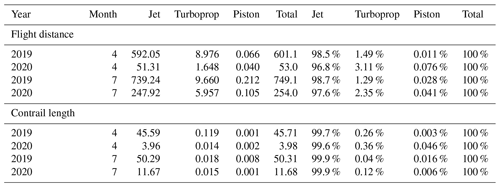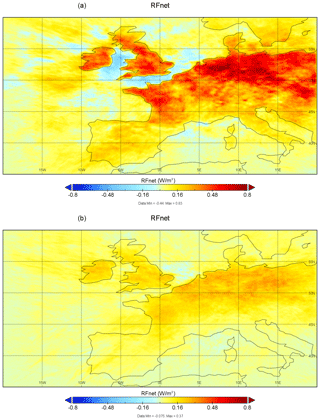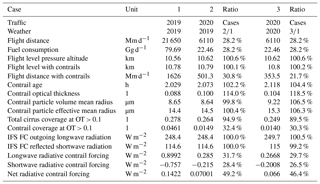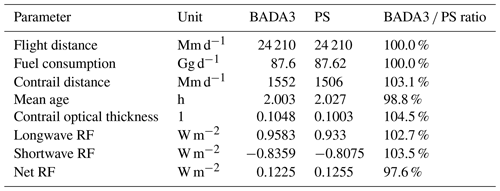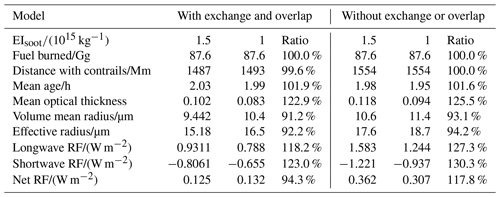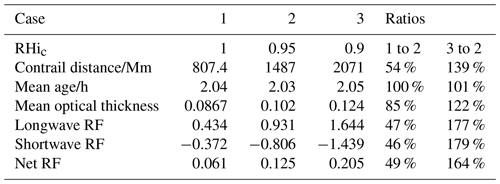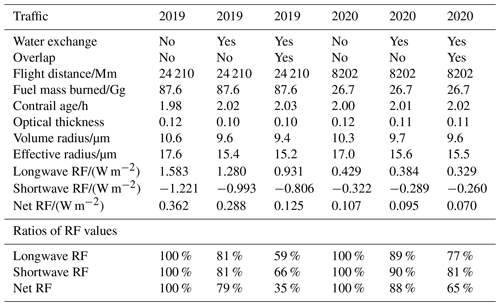the Creative Commons Attribution 4.0 License.
the Creative Commons Attribution 4.0 License.
Air traffic and contrail changes over Europe during COVID-19: a model study
Ian Poll
Roger Teoh
Rainer Koelle
Enrico Spinielli
Jarlath Molloy
George S. Koudis
Robert Baumann
Luca Bugliaro
Marc Stettler
Christiane Voigt
The strong reduction of air traffic during the COVID-19 pandemic provides a unique test case for the relationship between air traffic density, contrails, and their radiative forcing of climate change. Here, air traffic and contrail cirrus changes are quantified for a European domain for March to August 2020 and compared to the same period in 2019. Traffic data show a 72 % reduction in flight distance compared with 2019. This paper investigates the induced contrail changes in a model study. The contrail model results depend on various methodological details as discussed in parameter studies. In the reference case, the reduced traffic caused a reduction in contrail length. The reduction is slightly stronger than expected from the traffic change because the weather conditions in 2020 were less favorable for contrail formation than in 2019. Contrail coverage over Europe with an optical depth larger than 0.1 decreased from 4.6 % in 2019 to 1.4 % in 2020; the total cirrus cover amount changed by 28 % to 25 %. The reduced contrail coverage caused 70 % less longwave and 73 % less shortwave radiative forcing but, because of various nonlinearities, only 54 % less net forcing in this case. The methods include recently developed models for performance parameters and soot emissions. The overall propulsion efficiency of the aircraft is about 20 % smaller than estimated in earlier studies, resulting in 3 % fewer contrails. Considerable sensitivity to soot emissions is found, highlighting fuel and engine importance. The contrail model includes a new approximate method to account for water vapor exchange between contrails and background air and for radiative forcing changes due to contrail–contrail overlap. The water vapor exchange reduces available ice supersaturation in the atmosphere, which is critical for contrail formation. Contrail–contrail overlap changes the computed radiative forcing considerably. Comparisons to satellite observations are described and discussed in a parallel publication.
- Article
(13193 KB) - Full-text XML
-
Supplement
(247 KB) - BibTeX
- EndNote
Contrails induced by water vapor and soot emissions from aircraft flying in cold and humid air masses are responsible for a large part of the climate impact of aviation (Lee et al., 2021). Contrails cause positive longwave (LW) and negative shortwave (SW) instantaneous radiative forcing (RF) components at the top of the atmosphere (TOA) (Meerkötter et al., 1999). A positive net effect (sum of LW and SW contributions) induces a warming of the Earth–atmosphere system. Contrails and aircraft engine emissions interact with the atmosphere in a complex manner and not all aspects are well understood (Voigt et al., 2017; Kärcher, 2018; Gettelman et al., 2021; Lee et al., 2021). For example, contrails and aviation-induced aerosols affect ambient cirrus clouds, potentially causing negative RF (Lee et al., 2010; Penner et al., 2018). Even for positive instantaneous RF, the effective radiative forcing controlling the global mean surface temperature is likely to be smaller than the instantaneous changes at the TOA (Ponater et al., 2005; Rap et al., 2010; Bickel et al., 2020; Ponater et al., 2021). One cannot exclude the possibility that contrail shadows cool the Earth's surface regionally during daytime, while the all-day contrail greenhouse effect impacts the Earth's surface more slowly, partly after weeks and later, over larger domains, and with possibly lower warming efficacy (Schumann and Mayer, 2017).
Contrails have been observed in many studies, but observational evidence for contrail warming is missing. This is because the expected changes are small and not well correlated with contrail cover, and the observed changes may have many causes (Minnis et al., 2004; Minnis, 2005; Schumann and Heymsfield, 2017). Only a few studies have related observed regional cirrus cover and TOA irradiance changes to contrails (Duda et al., 2004; Mannstein and Schumann, 2005; Stordal et al., 2005; Stubenrauch and Schumann, 2005; Haywood et al., 2009; Graf et al., 2012; Schumann and Graf, 2013; Spangenberg et al., 2013). Early attempts to relate contrails to reduced diurnal temperature changes associated with air traffic changes over the USA in September 2001 (Travis et al., 2002) were shown to be inconclusive, mainly because of the shortness of the period with reduced traffic (Dietmüller et al., 2008; Hong et al., 2008).
As a result of the COVID-19 pandemic, since March 2020 air traffic has experienced a strong, global, and long-lasting reduction (ICAO, 2021). In April 2020, worldwide air traffic reduced by 80 % compared to April 2019 according to aircraft transponder data collected by Flightradar24 (https://www.flightradar24.com/blog/march-commercial-traffic-down-10-below-2019-so-far/, last access: 1 September 2020). The European Organisation for the Safety of Air Navigation (EUROCONTROL) reported an almost 90 % decrease in air traffic over Europe for the same period, exhibiting a minimum in mid-April with a slow recovery thereafter (https://www.eurocontrol.int/covid19, last access: 1 May 2020). The decrease was significantly larger than the 17 % decrease in CO2 emissions from global energy production in April 2020 compared to 2019 levels (Le Quéré et al., 2020).
This paper quantifies air traffic activity, the related contrail cirrus, and the radiative forcing for Europe from March to August in 2019 and 2020. A parallel paper compares the model results to satellite observations (Schumann et al., 2021). The investigation within 20∘ W to 20∘ E and 35 to 60∘ N covers much of Europe and the eastern parts of the North Atlantic that have high air traffic density and are visible from the geostationary satellite METEOSAT (Schmetz et al., 2002).
The contrails are simulated with the Contrail Cirrus Prediction Model (CoCiP) (Schumann, 2012), which has been used for various related studies (Schumann et al., 2017; Voigt et al., 2017; Teoh et al., 2020a, b). The contrail model uses traffic data from EUROCONTROL for a large part of Europe and from the UK air navigation service provider NATS for the Shanwick Oceanic Control Area. Performance parameters, including fuel consumption and overall propulsion efficiency, are estimated using the Base of Aircraft Data (BADA 3) from EUROCONTROL (Nuic et al., 2010; EUROCONTROL, 2015) and a recently developed open-access performance model for a set of subsonic turbofan-powered transport aircraft at cruise (Poll, 2018; Poll and Schumann, 2021a, b). Soot number emissions are computed with the fractal aggregate model (Teoh et al., 2019, 2020b). The model uses numerical weather prediction forecast (FC) data from the European Centre for Medium-Range Weather Forecasts (ECMWF) (Bauer et al., 2015). This paper describes the new traffic data set and its setup for 2019 and 2020. The data are used to quantify the changes in traffic, fuel consumption, soot emissions, contrail cover, RF, and the related TOA irradiances. CoCiP is run in various model versions to test the sensitivity of the results to model parameters, mainly in a new version approximating humidity exchange with background air and radiative contrail–contrail overlap inspired by some earlier studies (Burkhardt and Kärcher, 2011; Schumann et al., 2015; Sanz-Morère et al., 2021). A set of parameter studies is presented that identify the model sensitivity to input and model parameters.
This section briefly describes the database of air traffic and aircraft emissions over Europe in 2019 and 2020 used for the contrail simulations. As a minimum, the input data must characterize the flight tracks and emissions in the “upper” airspace above flight level (FL) 180 (18 000 feet, about 5.5 km), where most contrails form. Previous CoCiP studies have used air traffic from various sources, including a global track database for 2006 (Wilkerson et al., 2010; Brasseur et al., 2016), data collected for the field experiment ML-CIRRUS over Europe and the North Atlantic in March and April 2014 (Schumann et al., 2016; Voigt et al., 2017), or traffic data for 6 weeks distributed over one year in 2012–13 in Japanese airspace (Teoh et al., 2020b). Here, all flights passing the European investigation domain are considered. This includes all kerosene burning turbofan and turboprop engine aircraft. Input includes the aircraft type code, as defined by the International Civil Aviation Organization (ICAO), and the sequence of waypoints along the flight track. At each waypoint, the time, latitude, longitude, and FL, plus true airspeed, instantaneous aircraft mass, fuel flow rate, overall propulsion efficiency, and soot number emission index are specified, together with a unique running flight number and information on the traffic and performance data sources used. The simulation code requires input in hourly sections with constant time resolution. The construction of this input starts with the list of flights inside or passing Europe, followed by the whole route from departure to the destination airport, which is required in order to estimate the aircraft takeoff mass. This is then combined with meteorological wind and temperature data, and with performance and emission analyses, which are obtained from various sources in a sequence of processing steps (see Supplement).
The prime sources for the aircraft position information are the so-called Correlated Position Report (CPR) messages provided by EUROCONTROL's Performance Review Unit (PRU). These data originate from the pan-European air traffic management system operated by EUROCONTROL (Niarchakou and Cech, 2019). The CPR represents augmented surveillance position information based on real-time surveillance data (https://www.eurocontrol.int/service/data-collection-service, last access: 12 May 2021) derived from radar and from Automatic Dependent Surveillance–Broadcast (ADS-B) data (https://ads-b-europe.eu/, last access: 1 May 2021). For flights outside the surveillance domain of EUROCONTROL, data from EUROCONTROL's so-called Model 3 (M3) data (Wandelt and Sun, 2015) are used, which contain partial track information from departure to destination also outside Europe. The M3 data are flight plan data partly corrected by surveillance (radar) data and are available from the DDR2 data repository of EUROCONTROL. The M3 files provided by the PRU come directly from the network manager archives. For flights in the Shanwick control zone of the North Atlantic flight corridor, track information was provided by NATS. These were used to either replace or augment M3 data in that zone. The CPR data come without the ICAO aircraft type codes, but about 70 % of the CPR data contain the so-called ICAO 24 bit code, which is a unique aircraft identifier. A table relating many of the 24 bit codes with aircraft types was made available to us by Martin Schäfer within OpenSky (Schäfer et al., 2014). In other cases, the type code for CPR records was identified from the M3 or the NATS data for flights with same aircraft call sign, departure and destination locations, and departure time.
For comparisons (see Supplement), aircraft position data as collected from a distributed net of ground-received ADS-B data and as purchased from Fligthradar24 AB, Sweden (https://www.flightradar24.com/how-it-works, last access: 1 May 2021), were used. In addition, checks were performed by comparisons of the trajectory position data to position data obtained during flights of the DLR research aircraft. These confirmed that the position accuracy was on the order of 100 m in most cases.
Temperature and wind along the flight tracks are interpolated from global ERA5 reanalysis data, produced by ECMWF within the Copernicus Climate Change Service (Hersbach et al., 2020). Here, global 3-hourly data with 1∘ geographic resolution at pressure levels are used. True airspeed is computed by subtracting the wind speed vector from the groundspeed vector. Temperature is required for computing Mach and Reynolds numbers and related aircraft performance parameters.
The contrail analysis requires information about the local aircraft mass, local fuel flow rate (in kg s−1), and overall propulsion efficiency, together with water vapor mass and soot number emission indices per mass of burned fuel. Sensitivity studies with CoCiP show that a 10 % change in fuel consumption causes a change of about 7 % in contrail radiative forcing. Contrail formation depends on the overall propulsion efficiency, η, and an increase in η of 0.1 increases the threshold temperature by about 1.5 K (Schumann, 2000). Hence, more contrails form for larger η. Since most aircraft travel at temperatures about 5 to 12 K below the threshold temperature (Schumann and Heymsfield, 2017), the value of η has a smaller impact on the total mean contrail properties.
The fuel consumption rates and the overall propulsion efficiency are obtained from an aircraft performance model. In the past, the EUROCONTROL BADA3 model (Nuic et al., 2010; EUROCONTROL, 2015) was used for CoCiP studies (Schumann et al., 2011a). Alternatively, and in view of known limitations of the BADA3 method (Nuic et al., 2010), we use the self-contained and open-source model “PS” presented recently (Poll and Schumann, 2021a, b), with a slight modification to allow for the full range of Mach numbers at cruise. The PS method has a more rigorous aerodynamic foundation and covers Reynolds number effects.
Fuel consumption rate is directly proportional to the aircraft mass, which is derived by subtracting the integrated fuel mass burned from the takeoff mass. The takeoff mass is the sum of the operational empty aircraft mass, the payload mass, and the total fuel mass. Unfortunately, takeoff masses of aircraft are not recorded in a publicly available data set. Consequently, the takeoff mass is estimated using an assumed payload load factor, LF (ratio of actual payload mass to maximum permitted payload mass). Data from the US Bureau of Transportation Statistics, the German Statistical Federal Office, EUROCONTROL, and ICAO (see Supplement) suggest lower passenger and freight loadings after March 2020 than in the previous year (and more cargo flights). Therefore, LF is taken to be 0.7 for the time before the pandemic and 0.5 thereafter. The value 0.7 is found to be consistent with the actually flown FL profile staying below BADA3's estimate of the maximum altitude for the given mass (Eq. 3.5-1 EUROCONTROL, 2015) for most flights. The fuel mass is estimated from the total flight distance in air and mean cruise aircraft performance. The overall propulsion efficiency, η, is defined as the product of engine net thrust and true airspeed divided by the product of fuel flow rate and the lower calorific value of fuel (Cumpsty and Heyes, 2015). Both the fuel flow rate and the net thrust are provided by the performance model. The water vapor mass emission index and the lower calorific value of kerosene are set to 1.23 kg/kg and 43 MJ/kg, respectively.
Contrail properties are sensitive to the number of soot (or black carbon) particles emitted (Schumann et al., 2013a; Kärcher, 2016; Burkhardt et al., 2018; Teoh et al., 2020b). For example, optical depth increases with the third root of the soot number emission index (Schumann et al., 2013a). The soot number emission index depends strongly on the engine type and operation state. The black carbon (BC) number emissions index (EIn) is calculated using the fractal aggregates (FA) model (Teoh et al., 2020b); it estimates the BC EIn from the BC mass emissions index (BC EIm), particle size distribution (geometric mean diameter (GMD) and its standard deviation (GSD)), and morphology (Dfm). For each flight, the BC EIm is estimated using the formation and oxidization (FOX) method (Stettler et al., 2013) and improved FOX method (ImFOX) (Abrahamson et al., 2016), which are based on the thermodynamic and physical mechanisms by which BC is formed and oxidized. More specifically, the FOX method requires the overall pressure ratio of each engine type as an input to estimate the BC EIm, and we obtained this parameter from the ICAO Engine Emissions Data Bank (EDB). No smoke number measurements are required in the FOX and ImFOX methods. Since recently, the ICAO EDB provides non-volatile particle mass data; these are not used here because they are not available for older engines. The formulas and constants used to calculate the remaining parameters (GMD, GSD, and Dfm) can be found in Teoh et al. (2020b). In the few cases when these data are not available, a constant soot number emission index of 1015 kg−1 is assumed. The mean emission index from this method is about 3×1015 kg−1, with large variability (Teoh et al., 2020b). With this emission index, the number of ice crystals per fuel mass burned in young contrails would be about a factor of 2 larger than observed (Schumann et al., 2013a). This may indicate a size- or temperature-dependent efficiency of soot particles acting as cloud condensation and ice formation nucleus (Kärcher, 2016; Kleine et al., 2018; Lewellen, 2020). Therefore, the computed soot emission index value is halved in this study.
All these data are configured flight by flight, from departure to destination, without temporal interpolation and, finally, the flight tracks above FL 180 are split hourly and interpolated uniformly with 60 s time resolution. The resulting CoCiP input files require 36.8 GB (Gigabytes) of disc storage for March–August 2019 and 10.6 GB for the same period in 2020.
The mean traffic flight distances with respect to air (from true airspeed and time, not over ground) and mean fuel flow rates for the fleet of aircraft within the European investigation domain are listed in Table 3 for 2020 together with the percentage change relative to 2019. Figure 1 shows an example of the traffic tracks obtained from the various sources within two half-hour periods of 1 March 2020 (still “normal” traffic), one in the early morning with strong traffic from North America over the North Atlantic and one later in the morning with high traffic density over Europe. It can be seen that the CPR tracks are in good agreement with those from Flightradar24 (FR24). Apparently, many aircraft were equipped with ADS-B receivers from which the FR24 data are derived. The NATS data extend the CPR tracks in the Shanwick zone over the North Atlantic and the M3 data extend traffic in regions where surveillance data are missing.
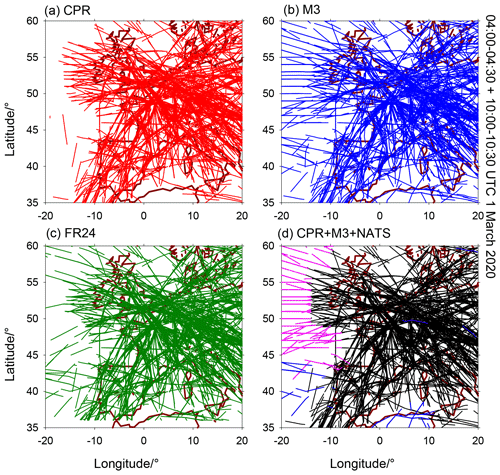
Figure 1Geographic map of the European domain under consideration for contrail simulations with colored flight tracks for two half-hour example time periods on 1 March 2020, before the COVID-19 crisis. Individual panels show track data from (a) CPR (red), (b) M3 (blue), (c) FR24 (green), and (d) the combination of CPR with M3 and NATS data for flights extending beyond the CPR range (black, blue, and purple lines).
As a result of the sudden change in demand and permissions for air transport, fleet operations in 2020 were very different from 2019. As illustrated in Fig. 2a, mean air traffic in the upper airspace (above FL 180) over Europe decreased considerably after mid-March 2020. The total flight distance per day decreased by 72 % on average over the 6-month period and by 91 % for the month of April in 2020 relative to 2019. Table 1 compares total air distance covered in flights above FL180 over the European domain in March–August 2020 compared to March–August 2019. Here, aircraft are split into five mass classes, as explained in the table caption, depending on the maximum permitted takeoff mass (MTOM) using BADA3 data for given ICAO aircraft types. In April 2020, the total distance flown decreased to 8.8 % of the April 2019 values. The reduction was strongest for light and medium-sized aircraft, i.e., single aisle transport and business jets, while general aviation aircraft (< 20 Mg) and heavy aircraft, i.e., twin aisle transport and cargo, experienced smaller reductions. By July 2020, light aircraft flight distances had returned to 70 % compared to the year before, while the average overall reduction was 23 % compared to July 2019.
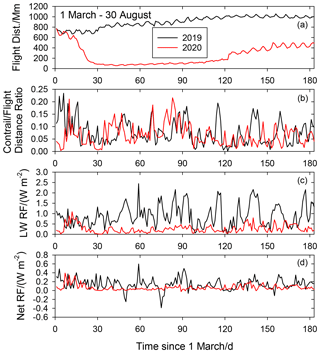
Figure 2Mean values of (a) flight distance in air, (b) ratio of mean flight distance with contrails to total flight distance, (c) longwave (LW) RF, and (d) net RF versus time from 1 March to 30 August in 2019 (black curves) and 2020 (red). The data represent averages over the European domain and over a 24 h day.
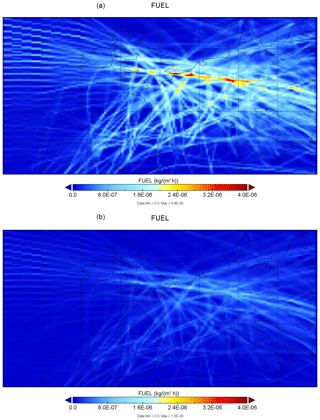
Figure 3Mean fuel consumption (in kg m−2 h−1) over the European domain from March–August in 2019 (a) and 2020 (b).
Figure 3 illustrates the spatial distribution of the mean traffic in terms of fuel consumption in the simulation domain for the 6 months on average in 2019 and 2020. Traffic and fuel consumption is largest along the route from London, UK, to Frankfurt am Main, Germany, but spreads along many other routes from the North Atlantic to the Near East and from Scandinavia to the Iberian Peninsula. Figure 3 also illustrates the large-scale traffic reduction in 2020 compared to 2019. The decrease of fuel consumption and flight distances are similar because the relative increase in aircraft weight (more cargo aircraft) is largely balanced by the lower load factor.
Table 1Flight distances (in Gm) of general aviation and military jets (G: MTOM < 20 Mg), light (L: 20 < MTOM < = 46 Mg), medium (M: 46 < MTOM/Mg < = 115), heavy (H: 126 < MTOM/Mg < = 395 Mg), and super heavy (S: 395 < MTOM/Mg) aircraft over Europe above FL 180 in the months of April (4) and July (7) in 2019 and 2020; absolute values and percentage fractions of 2019 values.
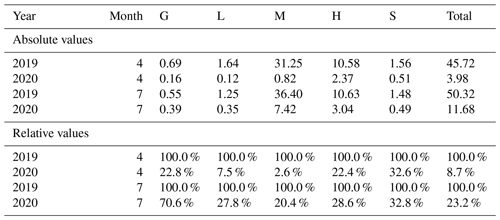
Turbofan powered (jet) aircraft are responsible for most of the air distance flown at flight levels above 180 (> 97.6 %) and for > 99.6 % of all contrails (see Table 2). The contribution to air distance flown from turboprops is far smaller (< 3.11 %) and even less for contrails (< 0.36 %). The contrail contribution from piston-engine aircraft is below 0.05%, largely because they usually operate at altitudes below FL 180.
Although 3-hourly ERA5 reanalysis pressure level data are used to provide the global traffic data with wind and temperature information, higher resolution deterministic operational numerical weather forecast (FC) data from the Integrated Forecasting System (IFS) of the ECMWF (Bauer et al., 2015) are used for contrail simulation in the investigation domain. IFS data are available for registered users. The IFS model used operates with a nominal resolution of 9 km horizontally, with 137 levels from the surface to model top at 0.01 hPa. Data are applied with 1 h time resolution and 0.25∘ horizontal geographic grid resolution. The mean vertical grid intervals in the IFS data between 200 and 300 hPa are about 10 hPa or 300 m for standard sea surface pressure. For comparison, the ERA5 data used are provided at fixed pressure levels, including 300, 250, 225, and 200 hPa, with vertical height intervals varying between 670 and 1200 m, i.e., with a much coarser vertical resolution. The forecasts provide hourly three-dimensional fields of pressure, temperature, wind components, humidity, ice water content, and cloud cover, plus two-dimensional fields for TOA irradiances of incoming solar direct radiation (SDR), reflected solar (RSR), and outgoing longwave radiation (OLR) on average over the recent hour.
A critical issue in the simulation of persistent contrails is the relative humidity with respect to saturation over ice (RHi) (Schumann, 1996; Lamquin et al., 2012; Irvine and Shine, 2015; Schumann and Heymsfield, 2017; Gierens et al., 2020). Here, RHi is derived from the FC data for temperature, pressure, and absolute humidity with given water vapor saturation pressure over ice (Sonntag, 1994). Several previous studies have found that ECMWF forecasts tend to underestimate the degree of ice supersaturation (Schumann and Graf, 2013; Kaufmann et al., 2018).
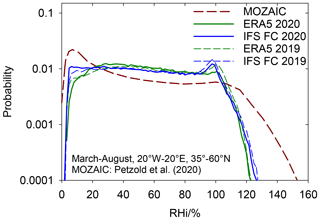
Figure 4Probability density of relative humidity over ice (RHi) from ECMWF IFS forecast data (FC, blue lines) and ERA5 re-analysis data (green) along the traffic routes over Europe as in 2020, evaluated separately for the meteorology of 2019 and 2020. The dark red dashed curve represents the 1995–2010 MOZAIC data as in Fig. 5a of Petzold et al. (2020).
Figure 4 compares the probability density function of relative humidity derived from the IFS FC with data from ERA5 and the airborne in situ measurements on routine Airbus flights during the MOZAIC project (Petzold et al., 2020). Here, the FC and ERA5 data represent the RHi from interpolated temperature and absolute humidity along the flight tracks above Europe between 180 and 310 hPa (about 12 and 8 km in the ICAO standard atmosphere) for the given time periods over Europe, while the MOZAIC data are from a longer time period and larger domain at the cruise levels of the Airbus A340 or A330 aircraft. Both numerical weather prediction data sets underestimate the occurrence of high ice supersaturation. Part of this underestimate probably comes from the higher resolution of the measurements in time and space compared to the grid cell and hourly mean values provided by the numerical weather predictions. To avoid an underestimate of simulated contrails in the past, CoCiP simulations were usually performed with enhanced humidity by dividing by a fixed model parameter RHic≤ 1. Previously, in order to obtain reasonable agreement between model estimates and the observations (Schumann and Graf, 2013), large changes were required (up to 1RHic= ). However, more recently the forecast resolution has improved and so an RHic equal to 0.95 is used in the reference cases and 1.0 and 0.9 in parameter studies. The potential contrail cover, i.e., the area fraction of air with a temperature below the contrail threshold value and RHi > 100 % derived from the FC data amounts to 15 % at FL 350 (10.6 km) on average over the investigation domain for RHic = 0.95, which agrees with estimates in the literature (Gierens et al., 2012) and shows that the selected RHic value is reasonable.
While the results given in Fig. 4 suggest that the quality of the ERA5 and FC data is about the same, the ERA5 data tend to underestimate wind shear, mainly because of the lower spatial resolution (see Fig. 5). Wind shear is important for simulating contrail dispersion. Without dispersion, contrails would remain narrow, triggering ice clouds in the aircraft wake only (Lewellen, 2014; Paoli and Shariff, 2016). However, with shear and turbulence driven dispersion, contrails grow in cross-section area and more and more contrail ice particles mix with ambient air, converting ambient ice supersaturation into contrail ice particles.
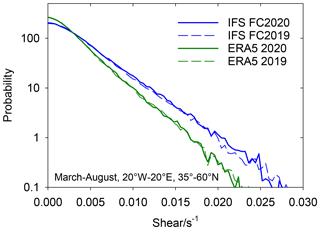
Figure 5Probability density of vertical shear of horizontal wind normal to flight segments along the traffic routes over Europe as in 2020, evaluated separately for the FC and ERA5 meteorology as in Fig. 4.
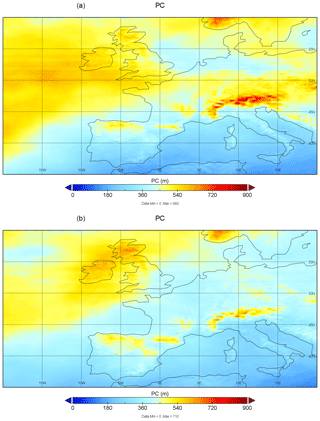
Figure 6Mean vertical thickness (in m) of layers conditioned for the formation of persistent contrails in March–August 2019 (a) and 2020 (b).
Another important parameter is the vertical wind. Adiabatic upward motion conserves mass specific humidity, but cools the air and, hence, enhances relative humidity, while downward motion reduces relative humidity (Gierens et al., 2012). Therefore, vertical wind is controlling the persistence and lifetime of ice supersaturated air masses and contrails. Inspection of several examples have shown that the ERA5 vertical wind is smoother in space and often smaller in magnitude than in the FC. Consequently, the FC data are preferred for contrail simulations.
Figure 6 gives an indication of the vertical depth of those layers suited to the formation of persistent contrails, as derived from the FC data. The air temperature inside these layers is below the Schmidt–Appleman threshold value for contrail formation (for η= 0.35) and humid enough for persistency (RHi > 1) (Schumann, 1996). The computed layer depth is limited by grid resolution and typically varies between 300 and 800 m, which is in the range of observations (Gierens et al., 2012). The values are largest over mountains because of frequent upgliding motions. Interestingly the thickness is larger over the North Atlantic than over the southern part of the domain. The geometric thickness of layers with relative humidity between ice saturation and liquid saturation in raising air masses increases for decreasing ambient temperature (Gierens et al., 2012) and the air temperature is lower at higher latitudes. Hence the thicker layers over the North Atlantic may be partly because of lower air temperature. The thickness of the ice supersaturated layer limits the altitude range in which sedimenting ice particles persist and hence the thickness influences maximum ice water content reached in contrails (Lewellen, 2014; Schumann et al., 2015). This ice water content and the geometrical depth also determine the optical thickness and, hence, influence the radiative forcing from contrails. Finally, the ice supersaturated layer thickness is important when discussing flight level changes to avoid warming contrails (Mannstein et al., 2005; Schumann et al., 2011a; Teoh et al., 2020a). Figure 6 also shows that the mean layer thickness over most of Europe was significantly larger in 2019 than in 2020, indicating that more contrails formed in 2019, not only because of more traffic but also because of more favorable contrail formation conditions.
The traffic, emission input, and FC data described above are used for the contrail model CoCiP (Schumann, 2012). CoCiP simulates Lagrangian contrail segments from the initial formation in air satisfying the Schmidt–Appleman criterion (Schumann, 1996) until the final decay for each 60 s flight segment. The contrail physics represented in this model is partly simplified compared to other models (Lewellen, 2014; Paoli and Shariff, 2016; Unterstrasser, 2016), but it resolves individual contrails and is applicable to global studies (Schumann et al., 2015). The model computes the local, contrail-induced RF of each contrail segment for given contrail properties and given TOA solar and thermal irradiances using an algebraic model (Schumann et al., 2012) for an ice particle habit mixture (see Table 2 in Schumann et al., 2011b) fitted to a set of reference data from libRadtran (Mayer and Kylling, 2005; Emde et al., 2016). The code reads the meteorological data hourly so that only two time slices are kept in the core storage at a given time. Contrails surviving the hour are kept in a separate buffer in core memory and integrated in time over the next hour. The spatial distributions of contrail properties are evaluated each hour on a grid with about a 4.2 km mean horizontal resolution prepared for comparisons with Meteosat-SEVIRI observations (Schmetz et al., 2002) by summing the contributions from all the contrail segments according to their Gaussian plume properties. This gridded analysis consumes about 90 % of the computing time. Without this evaluation part and after the preparation of all the input data, the Fortran code takes less than 5 min on a laptop computer to run with traffic for the month of July 2019. The model parameters are set as described previously (Schumann et al., 2015) but including variable soot number emission index EIs, humidity enhanced by a factor of 1RHic] (with RHic= 0.95), plume mixing enhanced by differential radiative heating, contrail segments integrated in the model's Runge–Kutta scheme with 1800 s time steps, and 10 h maximum contrail life time.
In regions of high traffic density, the amount of water entering contrails from ambient air may significantly dehydrate ambient air (Burkhardt and Kärcher, 2011; Schumann et al., 2015). Contrails take up water vapor from the ambient air and the first contrail formed reduces the ice supersaturation available for subsequent contrails flying later along about the same track (Unterstrasser, 2020). As explained in Sanz-Morère et al. (2021), contrail–contrail overlap also affects the radiative forcing. When one contrail is formed, it changes the irradiances OLR and RSR at the TOA. The RF is a function of these irradiances and reduced OLR and increased RSR values result in a smaller RF from the next contrail. A complete modeling of the humidity exchange and overlap effects would require integration of the prognostic equations for weather prediction and the related radiation transfer in time and space with resolution corresponding to the contrail scales. This is beyond the state of the art. Here, we account for humidity exchange with background air and contrail–contrail overlap in an approximate manner. For each contrail, the mass of water vapor that enters as contrail ice is subtracted from the background field, and the mass of ice from the sublimating contrails is returned to the background humidity, conserving total water mass in the corresponding grid cell volume. To account for contrail–contrail overlap in the RF analysis, the energy flux per grid cell area caused by the LW RF from a contrail is subtracted from the TOA OLR so that the RF from a subsequent overlapping contrail is driven by a reduced TOA flux. This ensures that the effective OLR (after subtraction of LW RF) stays positive. For the SW flux, the albedo a= RSR/SDR is increased as a function of the SW RF by |RF SW|/SDR. Here, SDR is the (incoming) solar direct radiation. This ensures that the increased albedo stays below 1. These corrections are applied contrail by contrail in the sequence in which they occur in the traffic input and the changes in the background air and TOA irradiances are lost when reading the next FC input hourly. The effects are demonstrated in the next section.
The contrail model has been applied and tested in several previous studies (Voigt et al., 2010; Schumann et al., 2011a; Jeßberger et al., 2013; Schumann and Graf, 2013; Schumann et al., 2013a, b, 2015, 2017; Voigt et al., 2017; Teoh et al., 2020b). Figure 7 demonstrates that the results from the improved method are both within the range of the previous results and within the scatter of observation data for individual contrails. Without humidity exchange, the amounts of contrail ice, its particle sizes, optical depth, and geometrical width and depth are between 10 % and 30 % larger. These changes are within the range of scatter of the observations.
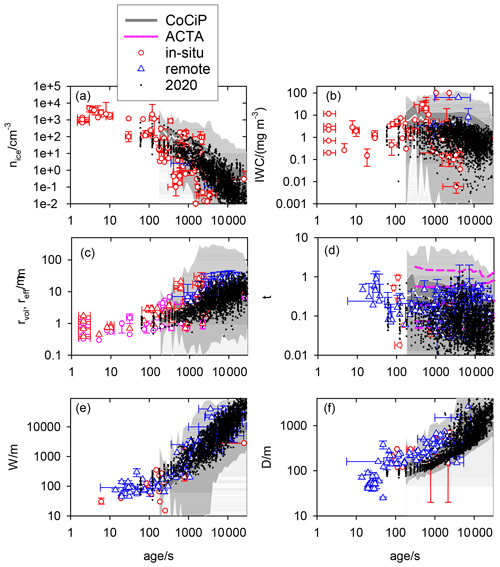
Figure 7Comparison of contrail model results with observed contrail properties versus contrail age. The gray areas with white lines representing 0 %, 10 %, 50 %, 90 %, and 100 % percentiles are from earlier multi-year CoCiP model results (Schumann et al., 2015). The colored symbols denote observations from in situ and remote sensing measurements. The panels show (a) ice particle number concentration nice, (b) ice water content IWC, (c) volume mean and effective ice particle radius rvol and reff, (d) optical thickness τ, (e) geometrical contrail width W, and (f) total geometrical contrail depth D. The purple lines in panel (d) are derived with the automatic contrail detection algorithm (ACTA) from satellite observations (Vázquez-Navarro et al., 2015). The black symbols that are overlaid over this previously published figure (Schumann et al., 2017; Schumann and Heymsfield, 2017) show computed contrail properties from the present study for a random subset of flight segments from 2020 in the reference model version.
Figure 2b–d show day mean contrail properties and RF for the European domain as a function of time for the 6-month period. The contrail contributions vary strongly from day to day because of variable weather. The ratio of contrail distance to flight distance is similar in both years, with a slight tendency to smaller ratios in 2020 because of the drier air. Similarly, the LW and SW RF values vary strongly and partially in anti-correlation. Hence, the day mean net RF is smaller, although positive on average. Some days with negative European mean net contrail RF are also found.
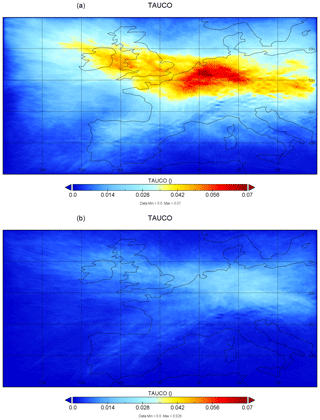
Figure 8Mean optical thickness of contrails from March–August in 2019 (a) and difference 2019–2020 (b).
Figure 8 gives the mean optical depth of the sum of all contrails from the simulations for 6 months in 2019 and the 2019–2020 difference and Fig. 9 shows the net RF. Both are computed taking humidity exchange with background air and contrail overlap into account. The given optical depth is the area mean of contrails per grid cell. This optical depth is seen to reach values up to 0.07 on average over these 6 months, with maximum changes of 0.054 between 2019 and 2020. However, it should be noted that this average includes contrail-free days. Far larger values are reached in individual contrail segments (see Fig. 7). The mean area coverage of contrails with an optical depth larger than 0.1 decreased from 4.6 % in 2019 to 1.4 % in 2020. The mean cirrus cover in the domain in these periods reaches up to 28 % (see Table 3). Hence, the computed relative changes in cirrus cover are of the order of 10 % of mean cirrus cover.
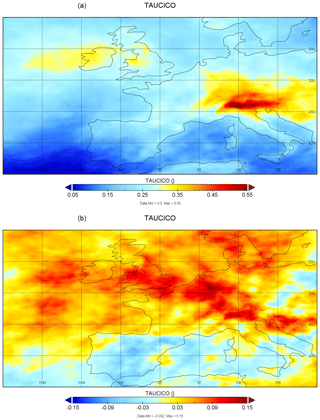
Figure 10Mean cirrus optical thickness (OT) (nondimensional) in the sum of IFS and CoCiP results from March–August in 2019 (a) and the 2019–2020 difference (b).
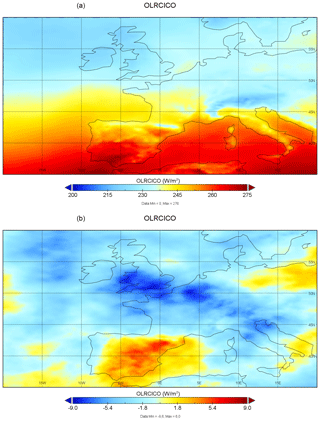
Figure 11Mean outgoing longwave radiation (OLR) in W m−2 in the sum of IFS and CoCiP results from March–August in 2019 (a) and the 2019–2020 difference (b).
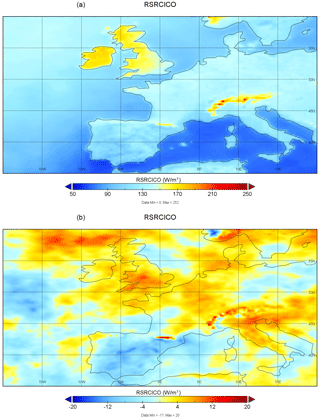
Figure 12Mean reflected solar radiation (RSR) in W m−2 in the sum of IFS and CoCiP results from March–August in 2019 (a) and the 2019–2020 difference (b).
The mean net RF varies from −0.2 to 0.8 W m−2 over Europe and is mostly positive. Mean negative values occur over sea surfaces mainly because of lower surface albedo than over land. Net RF values in 2020 are about 40 % lower than those in 2019. Hence, the reduction in net RF (60 %) is smaller than the reduction in traffic (72 %). This is due, in part, to different changes of SW and LW RF and to the nonlinear effects from contrail–background humidity exchange and contrail–contrail overlap.
Finally, data are shown that are comparable to satellite observations (Vázquez-Navarro et al., 2013; Strandgren et al., 2017; Schumann et al., 2021). These are optical depth (OT), OLR, and RSR from the sum of cirrus and contrails. The OT presented in Fig. 8 is the sum of the OT of cirrus from the FC data and the OT from contrails computed with CoCiP. Here, the OT of cirrus without contrails is estimated from the weather model output as a function of ice water content and temperature with effective ice particle diameters parameterized from observations at −81 to 0 ∘C temperatures (Heymsfield et al., 2014). The OLR given in Figure 11 is from the FC data minus the LW RF from contrails and the RSR in Fig. 12 is from the FC data minus the SW RF from contrails. We see large spatial variability of cirrus OT and the irradiances. The variability is largest for RSR because of changes in cloudiness, surface albedo, and seasonal changes in solar cycle. The plots and the mean values (see Table 3) suggest that the year 2019 had more cirrus coverage with OT > 0.1, less OLR, and less RSR compared to 2020. The differences show a band of changes between Ireland and the Balkan countries that resemble the expected aviation effects but are overlaid by changes from different weather. A further simulation with the weather of 2019 and traffic of 2020 quantifies the differences coming from the changes in weather. The mean contrail cover in 2020 (see Table 3) would have been 6 % larger if the weather in 2020 had been the same as in 2019. So, the weather impact on the contrail properties is smaller than the traffic impact on contrails. Compared to the background atmosphere, the contrail-induced changes reach about 10 % of the total cirrus cover and the LW RF values reach an order of 10 % of the spatial and temporal variability of OLR. The relative contribution of SW RF to RSR is smaller because of the larger variability of the RSR.
From plots like those shown in the lower panels of Figs. 10 to 12, one can read the maximum differences between 2019–2020, as listed in Table 4. The extreme values in the differences between 2019–2020 are positive for OT and OLR and negative for RSR, as expected for larger contrail–cirrus cover in 2019 compared to 2020. Comparing the values in Table 4, we note that the changes in the mean differences between 2019–2020 from total cirrus and irradiances changes are 3 to 10 times larger than the changes to be expected in contrail–cirrus OT and in LW and SW RF components. Obviously, weather changes had a stronger effect on these satellite-observable properties than air traffic in 2019–2020. In addition, we have to expect changes from other emissions (e.g., at the surface) not modeled in this study.
In addition to the variations in weather and traffic, the results are sensitive to various model and input parameters.
5.1 Sensitivity to the performance model used
Results from BADA3 and the new PS method (Poll and Schumann, 2021b) are very similar for fuel consumption, but there are large differences in the estimates of overall engine propulsion efficiency, η. These have consequences for the formation of contrails at threshold conditions. After preliminary studies showed that BADA3 overestimates η, we use BADA3 η values reduced by a factor of 0.85 in the reference simulation in this paper. A total of 184 ICAO aircraft types (or their BADA3 synonyms) contributed to the fuel consumption over Europe in 2019, 162 contributed to contrails in the year 2019 and 154 in 2020. The PS model currently provides data for 54 of these aircraft types. For 2019 traffic, the PS aircraft types account for 95 % of the fleet fuel consumption and 97 % of the total contrail forcing. In 2020, their contribution to contrail forcing is 91 %. Hence, the PS model with aircraft characteristics as given in the tables of Poll and Schumann (2021b) covers 91 % to 97 % of relevant aircraft types. Therefore, the PS method was used where possible. For aircraft types not covered in the current PS method and for climb and descent phases, BADA3 data are used.
As an aside, it was found that 80 % (90 %) of fuel consumption over Europe comes from just 15 (23) aircraft types, while 80 % (90 %) of the contrail forcing came from 13 (19) types in 2019 and from 16 (24) types in 2020. One particular aircraft type, a twin-engine medium-sized airliner, produced nearly 20 % of total fuel consumption and 16 % of contrail forcing in the same data set. The largest contrail contribution in 2020 came from one type of twin-engine heavy aircraft, probably as a result of the larger fraction of cargo flights in 2020 (ICAO, 2021).
Table 5 compares results for one month's traffic (July 2019) using the original BADA3 (η not corrected by a factor of 0.85 as in the reference case) and PS. The integrated fuel consumption differs by less than 1 %. For individual flights, the flight mean fuel consumption values at FL above 180 exhibit a Pearson correlation coefficient of 0.998. The η mean values and standard deviations at cruise are 0.38 ± 0.06 for BADA3 and 0.31 ± 0.05 for PS with a relative mean difference of (20 ± 9) % and mean correlation of 0.89. BADA3 tends to overestimate drag at cruise and, hence, engine thrust, as confirmed by a few comparisons to alternative performance models (BADA4 Nuic et al., 2010 and PIANO Simos, 2008). Since contrails form at higher temperature for higher η, more contrails form in the model runs when BADA3 is used compared to when the PS model is used. As expected, the total contrail flight distances differ by only about 3 % because many contrails occur at temperatures far below the threshold temperature. The mean optical depth and the mean RF values are 3 % to 5 % larger for BADA3 than for PS input. Incidentally, the net RF changes with similar magnitude but with a different sign because the added contrails for higher η occur mainly at lower altitudes contributing more to SW than to LW forcing. This clearly illustrates the non-linearity of the climate impact of contrail formation.
5.2 Sensitivity to soot emissions
The soot emission indices derived with the fractal aggregate model (Teoh et al., 2019) are, even after multiplication by the abovementioned adjustment factor of 0.5, on average 50 % larger than the fixed value 1× 1015 kg−1 used in an earlier CoCiP study (Schumann et al., 2015). As expected (Teoh et al., 2020b), Table 6 shows that a 50 % larger soot emission index causes a slightly larger contrail age (2 %), larger optical contrail thickness (25 %), and 20 % to 30 % larger RF values, with largest impact on the SW part. The increased particle number enhances SW effects more than LW. That is a known phenomenon (see Fig. 10 in Schumann et al., 2012).
5.3 Importance of relative humidity
The amount of ice supersaturation in the background atmosphere is the most important parameter for contrail modeling. The inverse of the parameter RHic is used to enhance humidity. Table 7 shows the sensitivity of domain mean values for one month with dense traffic (July 2019) to changes in RHic. Both absolute and relative values are given, compared to the results for RHic = 0.95. As expected, both the contrail length (flight distance with contrail formation) and their optical thickness increase strongly with increasing humidity. The overall impact of increasing, or decreasing, RHic by 5 % are changes in net RF on the order of 60 %. Obviously, the sensitivity to RHic is significant and the RHic value selected should be checked again when comparing the model results to observations.
Several other parameters are also important. For example, enhancing the vertical shear of horizontal wind by a factor of 2 or vertical diffusivities by similar amounts causes changes in RF on the order of 10 % to 20 %.
5.4 Sensitivity to the water vapor exchange and contrail overlap model
As can be seen from Table 8, the water exchange reduces the contrail optical thickness and the RF values by 10 % to 20 %, with the larger values being for the denser traffic in 2019. The water exchange causes less ice particle sedimentation and, hence, increases contrail lifetime on average by 1 % to 4 %, with the larger values for 2019 traffic. This is consistent with the results from a study with CoCiP coupled to a climate model (Schumann et al., 2015).
The contrail–contrail overlap causes a significant reduction in RF. In particular, the mean LW RF is reduced by 23 % for 2020 and by 41 % for 2019. The smaller reduction of the SW RF causes up to 65 % reduction in the net RF. As predicted (Sanz-Morère et al., 2021), these overlap aspects are important for regions with high traffic density.
In connection with the COVID-19 pandemic, global air traffic was considerably lower in 2020 compared to 2019 levels. This study has quantified air traffic and contrail changes within a European dense traffic area (20∘ W–20∘ E, 35–60∘ N) from March to August 2020 and compared them to the same months in 2019 using traffic data, emission estimates, ECMWF weather ERA5 reanalysis, IFS forecast data, and a contrail model. The traffic data show that total flight distance (with respect to air) in the European investigation domain for traffic operating above FL 180 was 72 % smaller in 2020 than in 2019. The changes in the total fuel consumption and soot emissions are similar. In the reference case, the model shows that the flight distance with persistent contrail formation was reduced even more strongly, by 78 %, mainly because the weather conditions in 2020 were less favorable for contrail formation than in 2019. The coverage of contrails with an optical depth larger than 0.1 decreased from 4.6 % in 2019 to 1.4 % in 2020. These are large changes in view of the about 25 % to 28 % mean cirrus cover. The reduced contrail coverage caused 70 % less LW and 73 % less SW RF and a significantly smaller reduction of 54 % in net RF.
In order to cover flights contributing to contrail formation as completely as possible, traffic data have been derived from a number of sources. There may still be gaps or inaccuracies over the Atlantic, where flight plan data have been used. This is particularly true south of the Shanwick area and possibly further north, where detailed traffic data are missing. In all other areas, the traffic should be accurately covered. The fuel consumption is assessed using two performance models, BADA3 and the new PS, and the results are similar. In estimating fuel use, the main uncertainty results from the unknown aircraft takeoff mass. In this study, the takeoff mass is determined by using the aircraft characteristics and an assumed mass load factor, i.e., payload mass fraction of maximum permitted payload. There are indications that the load factor was considerably reduced in the 2020 COVID-19 period. The new performance model PS provides a more accurate aircraft drag estimate at cruise giving a 10 % to 30 % reduction in the engine overall propulsion efficiency compared to BADA3. This affects contrails under threshold conditions and reduces contrail cover by about 3 % in total. As shown recently (Teoh et al., 2020b), the soot number emissions are larger than assumed in early contrail studies. A 50 % increase in the soot number results in a 30 % higher net RF. This again shows the importance of soot emissions and related fuel properties (Moore et al., 2017).
The contrail model includes a new, approximate method to account for water vapor exchange between contrails and background air and for RF in the case of contrail–contrail overlap. Water vapor exchange reduces the modeled RF magnitudes by about 10 % to 20 %, with larger values being for the denser traffic in 2019. The contrail–contrail overlap has an even stronger effect because the irradiances depend on the area covered by contrails, while the amount of water vapor exchange depends on the contrail volume and the volume fraction per grid cell of the rather thin contrails is smaller than their area fraction.
The 2019–2020 reductions in LW RF are larger than in SW RF and the net RF changed less than the SW and LW parts in this study. The SW and LW RF values have opposite signs and their mean magnitudes are 4 to 6 times larger than the net RF. Hence, small changes in the RF components have large impact on the net RF. The SW and LW RF components are partially correlated. However, the correlation is far different from 100 % because the SW and LW effects depend on different input values (temperature, solar zenith angle, system albedo, incoming solar irradiance, outgoing longwave irradiance, etc.) and respond to changes in the input parameters with different sensitivities. The SW/LW ratio also depends on the diurnal traffic cycle and the seasons considered. Therefore, several reasons cause different relative changes of net RF compared to the LW and SW components. The net RF may change more strongly than the LW and SW components in other situations.
It is not easy to identify air-traffic-induced changes in cirrus and irradiances over Europe in observations. The changes in total cirrus cover and irradiance values due to aviation are below 10 % of the background cirrus cover and the TOA irradiances without air traffic, in particular for SW irradiances. The aviation-induced changes are 3 to 10 times smaller than the mean differences in total cirrus and in TOA irradiances caused by weather changes in 2019–2020. These ratios are sensitive to model uncertainties. The 2019–2020 changes in weather had larger effects on contrail cirrus and its RF than the large traffic changes during COVID-19. Changes may also be caused by other aircraft emission (e.g., nitrogen oxides) (Brasseur et al., 2016) and by surface emissions.
Still, the traffic changes are large and last longer than the 6 months investigated so far. The traffic and the background atmosphere appear to be well characterized, and the contrail model has proven skill as demonstrated here again by comparison to a set of contrail observations. Much of the weather impact on background cirrus and irradiance changes in 2019–2020 is described by the IFS weather model. A 10 % change in cirrus cover and 10 % changes in OLR relative to the regional and temporal variability are not small, and regional and diurnal variation patterns may be detectable in observations.
Ideally, one should have accurate and representative observations that allow assessment of the accuracy of the model predictions. However, when we started this study, such observations were not available. Even now, with some recent observations (Schumann et al., 2021), the accuracy of model predictions can only be estimated because the observations have their own limitations.
The COVID-19 pandemic provided a new and unique opportunity to study the impact of aviation on cloudiness and radiative forcing. Further studies are needed to explain the differences between the model and observation results because the observed changes are caused not only by contrails but also by other anthropogenic and natural effects.
Key input data and some of the output data, as far as storage limits allowed, are made accessible in a public data repository (see Supplement). Further output and the contrail model code can be made available by the lead author upon request.
The supplement related to this article is available online at: https://doi.org/10.5194/acp-21-7429-2021-supplement.
US performed the study and wrote the manuscript; IP contributed to performance modeling; RT contributed to contrail and soot modeling and preprocessed NATS data; RK, ES, JM, and GSK contributed traffic data and related know how; RB prepared the ECMWF data; LB provided input for preparing comparisons to satellite data; and MS and CV contributed to the conceptual design and many details of the study. All authors contributed to manuscript editing.
The authors declare that they have no conflict of interest.
The article processing charges for this open-access publication were covered by the German Aerospace Center (DLR).
This paper was edited by Johannes Quaas and reviewed by two anonymous referees.
Abrahamson, J. P., Zelina, J., Andac, M. G., and Vander Wal, R. L.: Predictive model development for aviation black carbon mass emissions from alternative and conventional fuels at ground and cruise, Environ. Sci. Technol., 50, 12048–12055, https://doi.org/10.1021/acs.est.6b03749 2016.
Bauer, P., Thorpe, A., and Brunet, G.: The quiet revolution of numerical weather prediction, Nature, 525, 47–55, https://doi.org/10.1038/nature14956, 2015.
Bickel, M., Ponater, M., Bock, L., Burkhardt, U., and Reineke, S.: Estimating the effective radiative forcing of contrail cirrus, J. Climate, 33, 1991–2005, https://doi.org/10.1175/JCLI-D-19-0467.1, 2020.
Brasseur, G. P., Gupta, M., Anderson, B. E., Balasubramanian, S., Barrett, S., Duda, D., Fleming, G., Forster, P. M., Fuglestvedt, J., Gettelman, A., Halthore, R. N., Jacob, S. D., Jacobson, M. C., Khodayari, A., Liou, K.-N., Lund, M. T., Miake-Lye, R. C., Minnis, P., Olsen, S. C., Penner, J. E., Prinn, R., Schumann, U., Selkirk, H. B., Sokolov, A., Unger, N., Wolfe, P., Wong, H.-W., Wuebbles, D. W., Yi, B., Yang, P., and Zhou, C.: Impact of aviation on climate: FAA's Aviation Climate Change Research Initiative (ACCRI) Phase II, B. Am. Meteorol. Soc., 97, 561–583, https://doi.org/10.1175/BAMS-D-13-00089.1, 2016.
Burkhardt, U. and Kärcher, B.: Global radiative forcing from contrail cirrus, Nature Clim. Change, 1, 54–58, https://doi.org/10.1038/NCLIMATE1068, 2011.
Burkhardt, U., Bock, L., and Bier, A.: Mitigating the contrail cirrus climate impact by reducing aircraft soot number emissions, NPJ Climate and Atmospheric Science, 1, 37, https://doi.org/10.1038/s41612-018-0046-4, 2018.
Cumpsty, N. and Heyes, A.: Jet Propulsion, 3rd edition, Cambridge University Press, Cambridge, UK, 351 pp., 2015.
Dietmüller, S., Ponater, M., Sausen, R., Hoinka, K.-P., and Pechtl, S.: Contrails, natural clouds, and diurnal temperature range, J. Climate, 21, 5061–5075, 10.1175/2008JCLI2255.1, 2008.
Duda, D. P., Minnis, P., Nyuyen, L., and Palikonda, R.: A case study of the development of contrail clusters over the Great Lakes, J. Atmos. Sci., 61, 1132–1146, 2004.
Emde, C., Buras-Schnell, R., Kylling, A., Mayer, B., Gasteiger, J., Hamann, U., Kylling, J., Richter, B., Pause, C., Dowling, T., and Bugliaro, L.: The libRadtran software package for radiative transfer calculations (version 2.0.1), Geosci. Model Dev., 9, 1647–1672, https://doi.org/10.5194/gmd-9-1647-2016, 2016.
EUROCONTROL: User Manual for the Base of Aircraft Data (BADA) Revision 3.13, EUROCONTROL Experimental Centre, Brétigny-sur-Orge, France, EEC Technical Report No. 15/04/02-43, 105 pp., 2015.
Gettelman, A., Chen, C.-C., and Bardeen, C. G.: The Climate Impact of COVID19 Induced Contrail Changes, Atmos. Chem. Phys. Discuss. [preprint], https://doi.org/10.5194/acp-2021-210, in review, 2021.
Gierens, K., Spichtinger, P., and Schumann, U.: Ice supersaturation, in: Atmospheric Physics – Background – Methods – Trends, edited by: Schumann, U., Springer, Berlin, Heidelberg, https://doi.org/10.1007/978-3-642-30183-4_9, 2012.
Gierens, K., Matthes, S., and Rohs, S.: How well can persistent contrails be predicted?, Aerospace, 7, 179, https://doi.org/10.3390/aerospace7120169, 2020.
Graf, K., Schumann, U., Mannstein, H., and Mayer, B.: Aviation induced diurnal North Atlantic cirrus cover cycle, Geophys. Res. Lett., 39, L16804, https://doi.org/10.1029/2012GL052590, 2012.
Haywood, J. M., Allan, R. P., Bornemann, J., Forster, P. M., Francis, P. N., Milton, S., Rädel, G., Rap, A., Shine, K. P., and Thorpe, R.: A case study of the radiative forcing of persistent contrails evolving into contrail-induced cirrus, J. Geophys. Res., 114, D24201, https://doi.org/10.1029/2009JD012650, 2009.
Hersbach, H., Bell, B., Berrisford, P., Hirahara, S., Horányi, A., Muñoz-Sabater, J., Nicolas, J., Peubey, C., Radu, R., Schepers, D., Simmons, A., Soci, C., Abdalla, S., Abellan, X., Balsamo, G., Bechtold, P., Biavati, G., Bidlot, J., Bonavita, M., De Chiara, G., Dahlgren, P., Dee, D., Diamantakis, M., Dragani, R., Flemming, J., Forbes, R., Fuentes, M., Geer, A., Haimberger, L., Healy, S., Hogan, R. J., Hólm, E., Janisková, M., Keeley, S., Laloyaux, P., Lopez, P., Lupu, C., Radnoti, G., de Rosnay, P., Rozum, I., Vamborg, F., Villaume, S., and Thépaut, J. N.: The ERA5 global reanalysis, Q. J. Roy. Meteorol. Soc., 146, 1999–2049, https://doi.org/10.1002/qj.3803, 2020.
Heymsfield, A., Winker, D., Avery, M., Vaughan, M., Diskin, G., Deng, M., Mitev, V., and Matthey, R.: Relationships between ice water content and volume extinction coefficient from in situ observations for temperatures from 0∘ to −86 ∘C: Implications for spaceborne lidar retrievals, J. Appl. Meteorol. Clim., 53, 479–505, https://doi.org/10.1175/JAMC-D-13-087.1, 2014.
Hong, G., Yang, P., Minnis, P., Hu, Y. X., and North, G.: Do contrails significantly reduce daily temperature range?, Geophys. Res. Lett., 35, L23815, https://doi.org/10.1029/2008GL036108, 2008.
ICAO: Effects of novel coronavirus (COVID-19) on civil aviation: Economic impact analysis, Montreal, available at: https://www.icao.int/sustainability/Documents/Covid-19/ICAO_coronavirus_Econ_Impact.pdf (last access: 1 May 2021), 125 pp., 2021.
Irvine, E. A. and Shine, K. P.: Ice supersaturation and the potential for contrail formation in a changing climate, Earth Syst. Dynam., 6, 555–568, https://doi.org/10.5194/esd-6-555-2015, 2015.
Jeßberger, P., Voigt, C., Schumann, U., Sölch, I., Schlager, H., Kaufmann, S., Petzold, A., Schäuble, D., and Gayet, J.-F.: Aircraft type influence on contrail properties, Atmos. Chem. Phys., 13, 11965–11984, https://doi.org/10.5194/acp-13-11965-2013, 2013.
Kärcher, B.: The importance of contrail ice formation for mitigating the climate impact of aviation, J. Geophys. Res., 121, 3497–3505, https://doi.org/10.1002/2015JD024696, 2016.
Kärcher, B.: Formation and radiative forcing of contrail cirrus, Nat. Commun., 9, 1824, https://doi.org/10.1038/s41467-018-04068-0, 2018.
Kaufmann, S., Voigt, C., Heller, R., Jurkat-Witschas, T., Krämer, M., Rolf, C., Zöger, M., Giez, A., Buchholz, B., Ebert, V., Thornberry, T., and Schumann, U.: Intercomparison of midlatitude tropospheric and lower-stratospheric water vapor measurements and comparison to ECMWF humidity data, Atmos. Chem. Phys., 18, 16729–16745, https://doi.org/10.5194/acp-18-16729-2018, 2018.
Kleine, J., Voigt, C., Sauer, D., Schlager, H., Scheibe, M., Jurkat-Witschas, T., Kaufmann, S., Kärcher, B., and Anderson, B. E.: In situ observations of ice particle losses in a young persistent contrail, Geophys. Res. Lett., 45, 13553–13561, https://doi.org/10.1029/2018GL079390, 2018.
Lamquin, N., Stubenrauch, C. J., Gierens, K., Burkhardt, U., and Smit, H.: A global climatology of upper-tropospheric ice supersaturation occurrence inferred from the Atmospheric Infrared Sounder calibrated by MOZAIC, Atmos. Chem. Phys., 12, 381–405, https://doi.org/10.5194/acp-12-381-2012, 2012.
Lee, D. S., Pitari, G., Grewe, V., Gierens, K., Penner, J. E., Petzold, A., Prather, M. J., Schumann, U., Bais, A., Berntsen, T., Iachetti, D., Lim, L. L., and Sausen, R.: Transport impacts on atmosphere and climate: Aviation, Atmos. Environ., 44, 4678–4734, https://doi.org/10.1016/j.atmosenv.2009.06.005, 2010.
Lee, D. S., Fahey, D. W., Skowron, A., Allen, M. R., Burkhardt, U., Chen, Q., Doherty, S. J., Freeman, S., Forster, P. M., Fuglestvedt, J., Gettelman, A., Leon, R. R. D., Lim, L. L., Lund, M. T., Millar, R. J., Owen, B., Penner, J. E., Pitari, G., Prather, M. J., Sausen, R., and Wilcox, L. J.: The contribution of global aviation to anthropogenic climate forcing for 2000 to 2018, Atmos. Environ., 244, 117834, https://doi.org/10.1016/j.atmosenv.2020.117834, 2021.
Le Quéré, C., Jackson, R. B., Jones, M. W., Smith, A. J. P., Abernethy, S., Andrew, R. M., De-Gol, A. J., Willis, D. R., Shan, Y., Canadell, J. G., Friedlingstein, P., Creutzig, F., and Peters, G. P.: Temporary reduction in daily global CO2 emissions during the COVID-19 forced confinement, Nat. Clim. Change, 10, 647–653, https://doi.org/10.1038/s41558-020-0797-x, 2020.
Lewellen, D. C.: Persistent contrails and contrail cirrus. Part II: Full lifetime behavior, J. Atmos. Sci., 71, 4420–4438, https://doi.org/10.1175/JAS-D-13-0317.1, 2014.
Lewellen, D. C.: A large-eddy simulation study of contrail ice number formation, J. Atmos. Sci., 77, 2585–2604, https://doi.org/10.1175/JAS-D-19-0322.1, 2020.
Mannstein, H. and Schumann, U.: Aircraft induced contrail cirrus over Europe, Meteorol. Z., 14, 549–554, 10.1127/0941-2948/2005/0058, 2005.
Mannstein, H., Spichtinger, P., and Gierens, K.: How to avoid contrail cirrus, Transp. Res., 10, 421–426, https://doi.org/10.1016/j.trd.2005.04.012, 2005.
Mayer, B. and Kylling, A.: Technical note: The libRadtran software package for radiative transfer calculations – description and examples of use, Atmos. Chem. Phys., 5, 1855–1877, https://doi.org/10.5194/acp-5-1855-2005, 2005.
Meerkötter, R., Schumann, U., Doelling, D. R., Minnis, P., Nakajima, T., and Tsushima, Y.: Radiative forcing by contrails, Ann. Geophys., 17, 1080–1094, https://doi.org/10.1007/s00585-999-1080-7, 1999.
Minnis, P.: Reply, J. Climate, 18, 2783–2784, https://doi.org/10.1175/JCLI3434.1, 2005.
Minnis, P., Ayers, J. K., Palikonda, R., and Phan, D.: Contrails, cirrus trends, and climate, J. Climate, 17, 1671–1685, https://doi.org/10.1175/1520-0442(2004)017<1671:CCTAC>2.0.CO;2, 2004.
Moore, R. H., Thornhill, K. L., Weinzierl, B., Sauer, D., D'Ascoli, E., Kim, J., Lichtenstern, M., Scheibe, M., Beaton, B., Beyersdorf, A. J., Barrick, J., Bulzan, D., Corr, C. A., Crosbie, E., Jurkat, T., Martin, R., Riddick, D., Shook, M., Slover, G., Voigt, C., White, R., Winstead, E., Yasky, R., Ziemba, L. D., Brown, A., Schlager, H., and Anderson, B. E.: Biofuel blending reduces particle emissions from aircraft engines at cruise conditions, Nature, 543, 411–415, https://doi.org/10.1038/nature21420, 2017.
Niarchakou, S. and Cech, M.: ATFCM OPERATIONS MANUAL Network Manager, Edition Number: 23.1, EUROCONTROL, available at: https://www.eurocontrol.int/sites/default/files/2019-05/ifps-users-manual-current.pdf (last access: 12 May 2021), 216 pp., 2019.
Nuic, A., Poles, D., and Mouillet, V.: BADA: An advanced aircraft performance model for present and future ATM systems, Int. J. Adapt. Control, 24, 850–866, https://doi.org/10.1002/acs.1176, 2010.
Paoli, R. and Shariff, K.: Contrail modeling and simulation, Annu. Rev. Fluid Mech., 48, 393–427, https://doi.org/10.1146/annurev-fluid-010814-013619, 2016.
Penner, J. E., Zhou, C., Garnier, A., and Mitchell, D. L.: Anthropogenic aerosol indirect effects in cirrus clouds, J. Geophys. Res., 123, 11652–11677, https://doi.org/10.1029/2018JD029204, 2018.
Petzold, A., Neis, P., Rütimann, M., Rohs, S., Berkes, F., Smit, H. G. J., Krämer, M., Spelten, N., Spichtinger, P., Nédélec, P., and Wahner, A.: Ice-supersaturated air masses in the northern mid-latitudes from regular in situ observations by passenger aircraft: vertical distribution, seasonality and tropospheric fingerprint, Atmos. Chem. Phys., 20, 8157–8179, https://doi.org/10.5194/acp-20-8157-2020, 2020.
Poll, D. I. A.: On the relationship between non-optimum operations and fuel requirement for large civil transport aircraft, with reference to environmental impact and contrail avoidance strategy, Aero. J., 122, 1827–1870, https://doi.org/10.1017/aer.2018.121 2018.
Poll, D. I. A. and Schumann, U.: An estimation method for the fuel burn and other performance characteristics of civil transport aircraft in the cruise. Part 1: fundamental quantities and governing relations for a general atmosphere, Aero. J., 125, 296–340, https://doi.org/10.1017/aer.2020.62, 2021a.
Poll, D. I. A. and Schumann, U.: An estimation method for the fuel burn and other performance characteristics of civil transport aircraft during cruise: Part 2, determining the aircraft's characteristic parameters, Aero. J., 125, 257–295, https://doi.org/10.1017/aer.2020.124, 2021b.
Ponater, M., Marquart, S., Sausen, R., and Schumann, U.: On contrail climate sensitivity, Geophys. Res. Lett., 32, L10706, 10.1029/2005gl022580, 2005.
Ponater, M., Bickel, M., Bock, L., and Burkhardt, U.: Towards determining the contrail cirrus efficacy, Aerospace, 8, 1–10, https://doi.org/10.3390/aerospace8020042, 2021.
Rap, A., Forster, P. M., Haywood, J. M., Jones, A., and Boucher, O.: Estimating the climate impact of linear contrails using the UK Met Office climate model, Geophys. Res. Lett., 37, L20703, https://doi.org/10.1029/2010GL045161, 2010.
Sanz-Morère, I., Eastham, S. D., Allroggen, F., Speth, R. L., and Barrett, S. R. H.: Impacts of multi-layer overlap on contrail radiative forcing, Atmos. Chem. Phys., 21, 1649–1681, https://doi.org/10.5194/acp-21-1649-2021, 2021.
Schäfer, M., Strohmeier, M., Lenders, V., Martinovic, I., and Wilhelm, M.: Bringing up OpenSky: A Large-scale ADS-B Sensor Network for Research, IPSN-14 Proceedings of the 13th International Symposium on Information Processing in Sensor Networks, Berlin, Germany, 83–94, https://doi.org/10.1109/IPSN.2014.6846743, 2014.
Schmetz, J., Pili, P., Tjemkes, S., Just, D., Kerkmann, J., Rota, S., and Ratier, A.: An introduction to Meteosat Second Generation (MSG), B. Am. Meteorol. Soc., 83, 977–992, https://doi.org/10.1175/BAMS-83-7-Schmetz-2, 2002.
Schumann, U.: On conditions for contrail formation from aircraft exhausts, Meteorol. Z., 5, 4–23, https://doi.org/10.1127/metz/5/1996/4, 1996.
Schumann, U.: Influence of propulsion efficiency on contrail formation, Aerosp. Sci. Technol., 4, 391–401, https://doi.org/10.1016/S1270-9638(00)01062-2, 2000.
Schumann, U.: A contrail cirrus prediction model, Geosci. Model Dev., 5, 543–580, https://doi.org/10.5194/gmd-5-543-2012, 2012.
Schumann, U. and Graf, K.: Aviation-induced cirrus and radiation changes at diurnal timescales, J. Geophys. Res., 118, 2404–2421, https://doi.org/10.1002/jgrd.50184, 2013.
Schumann, U. and Heymsfield, A.: On the lifecycle of individual contrails and contrail cirrus, Meteor. Mon., 58, 3.1–3.24, https://doi.org/10.1175/AMSMONOGRAPHS-D-16-0005.1, 2017.
Schumann, U. and Mayer, B.: Sensitivity of surface temperature to radiative forcing by contrail cirrus in a radiative-mixing model, Atmos. Chem. Phys., 17, 13833–13848, https://doi.org/10.5194/acp-17-13833-2017, 2017.
Schumann, U., Graf, K., and Mannstein, H.: Potential to reduce the climate impact of aviation by flight level changes, AIAA paper 2011-3376, 1–22, https://doi.org/10.2514/6.2011-3376, 2011a.
Schumann, U., Mayer, B., Gierens, K., Unterstrasser, S., Jessberger, P., Petzold, A., Voigt, C., and Gayet, J.-F.: Effective radius of ice particles in cirrus and contrails, J. Atmos. Sci., 68, 300–321, https://doi.org/10.1175/2010JAS3562.1, 2011b.
Schumann, U., Mayer, B., Graf, K., and Mannstein, H.: A parametric radiative forcing model for contrail cirrus, J. Appl. Meteorol. Clim., 51, 1391–1406, https://doi.org/10.1175/JAMC-D-11-0242.1, 2012.
Schumann, U., Jeßberger, P., and Voigt, C.: Contrail ice particles in aircraft wakes and their climatic importance, Geophys. Res. Lett., 40, 2867–2872 https://doi.org/10.1002/grl.50539, 2013a.
Schumann, U., Hempel, R., Flentje, H., Garhammer, M., Graf, K., Kox, S., Lösslein, H., and Mayer, B.: Contrail study with ground-based cameras, Atmos. Meas. Tech., 6, 3597–3612, https://doi.org/10.5194/amt-6-3597-2013, 2013b.
Schumann, U., Penner, J. E., Chen, Y., Zhou, C., and Graf, K.: Dehydration effects from contrails in a coupled contrail–climate model, Atmos. Chem. Phys., 15, 11179–11199, https://doi.org/10.5194/acp-15-11179-2015, 2015.
Schumann, U., Graf, K., Bugliaro, L., Dörnbrack, A., Voigt, C., Wirth, M., Ziereis, H., Giez, A., and Minikin, A.: Contrail predictions for ML-CIRRUS – Method and Experiences, TAC4, Bad Kohlgrub, DLR FB 2015-38, 132–138, 2016.
Schumann, U., Baumann, R., Baumgardner, D., Bedka, S. T., Duda, D. P., Freudenthaler, V., Gayet, J.-F., Heymsfield, A. J., Minnis, P., Quante, M., Raschke, E., Schlager, H., Vázquez-Navarro, M., Voigt, C., and Wang, Z.: Properties of individual contrails: a compilation of observations and some comparisons, Atmos. Chem. Phys., 17, 403–438, https://doi.org/10.5194/acp-17-403-2017, 2017.
Schumann, U., Bugliaro, L., Dörnbrack, A., Baumann, R., and Voigt, C.: Aviation contrail cirrus and radiative forcing over Europe during 6 months of COVID-19, Geophys. Res. Lett., 48, e2021GL092771, https://doi.org/10.1029/2021GL092771, 2021.
Simos, D.: PIANO User's Guide, Version 4.0 [online manual], Lissys, Ltd., Woodhouse Eaves, UK, available at: https://www.lissys.uk/ (last access: 11 May 2021), 2008.
Sonntag, D.: Advancements in the field of hygrometry, Meteorol. Z., 3, 51–66, https://doi.org/10.1127/metz/3/1994/51, 1994.
Spangenberg, D. A., Minnis, P., Bedka, S. T., Palikonda, R., Duda, D. P., and Rose, F. G.: Contrail radiative forcing over the Northern Hemisphere from 2006 Aqua MODIS data, Geophys. Res. Lett., 40, 595–600, https://doi.org/10.1002/grl.50168, 2013.
Stettler, M. E. J., Boies, A. M., Petzold, A., and Barrett, S. R. H.: Global civil aviation black carbon emissions, Environ. Sci. Technol., 47, 10397–10404, https://doi.org/10.1021/es401356v, 2013.
Stordal, F., Myhre, G., Stordal, E. J. G., Rossow, W. B., Lee, D. S., Arlander, D. W., and Svendby, T.: Is there a trend in cirrus cloud cover due to aircraft traffic?, Atmos. Chem. Phys., 5, 2155–2162, https://doi.org/10.5194/acp-5-2155-2005, 2005.
Strandgren, J., Bugliaro, L., Sehnke, F., and Schröder, L.: Cirrus cloud retrieval with MSG/SEVIRI using artificial neural networks, Atmos. Meas. Tech., 10, 3547–3573, https://doi.org/10.5194/amt-10-3547-2017, 2017.
Stubenrauch, C. J. and Schumann, U.: Impact of air traffic on cirrus coverage, Geophys. Res. Lett., 32, L14813, https://doi.org/10.1029/2005GL022707, 2005.
Teoh, R., Stettler, M. E. J., Majumdar, A., Schumann, U., Graves, B., and Boies, A.: A methodology to relate black carbon particle number and mass emissions, J. Aerosp. Sci., 132, 44-59, https://doi.org/10.1016/j.jaerosci.2019.03.006, 2019.
Teoh, R., Schumann, U., and Stettler, M. E. J.: Beyond contrail avoidance: Efficacy of flight altitude changes to minimise contrail climate forcing, Aerospace, 7, 121, https://doi.org/10.3390/aerospace7090121, 2020a.
Teoh, R., Schumann, U., Majumdar, A., and Stettler, M. E. J.: Mitigating the climate forcing of aircraft contrails by small-scale diversions and technology adoption, Environ. Sci. Technol., 54, 2941–2950, https://doi.org/10.1021/acs.est.9b05608, 2020b.
Travis, D. J., Carleton, A. M., and Lauritsen, R. G.: Contrails reduce daily temperature range, brief communications, Nature, 418, 601, https://doi.org/10.1038/418601a, 2002.
Unterstrasser, S.: Properties of young contrails – a parametrisation based on large-eddy simulations, Atmos. Chem. Phys., 16, 2059–2082, https://doi.org/10.5194/acp-16-2059-2016, 2016.
Unterstrasser, S.: The contrail mitigation potential of aircraft formation flight derived from high-resolution simulations, Aerospace, 7, 170, https://doi.org/10.3390/aerospace7120170, 2020.
Vázquez-Navarro, M., Mayer, B., and Mannstein, H.: A fast method for the retrieval of integrated longwave and shortwave top-of-atmosphere upwelling irradiances from MSG/SEVIRI (RRUMS), Atmos. Meas. Tech., 6, 2627–2640, https://doi.org/10.5194/amt-6-2627-2013, 2013.
Vázquez-Navarro, M., Mannstein, H., and Kox, S.: Contrail life cycle and properties from 1 year of MSG/SEVIRI rapid-scan images, Atmos. Chem. Phys., 15, 8739–8749, https://doi.org/10.5194/acp-15-8739-2015, 2015.
Voigt, C., Schumann, U., Jurkat, T., Schäuble, D., Schlager, H., Petzold, A., Gayet, J.-F., Krämer, M., Schneider, J., Borrmann, S., Schmale, J., Jessberger, P., Hamburger, T., Lichtenstern, M., Scheibe, M., Gourbeyre, C., Meyer, J., Kübbeler, M., Frey, W., Kalesse, H., Butler, T., Lawrence, M. G., Holzäpfel, F., Arnold, F., Wendisch, M., Döpelheuer, A., Gottschaldt, K., Baumann, R., Zöger, M., Sölch, I., Rautenhaus, M., and Dörnbrack, A.: In-situ observations of young contrails – overview and selected results from the CONCERT campaign, Atmos. Chem. Phys., 10, 9039–9056, https://doi.org/10.5194/acp-10-9039-2010, 2010.
Voigt, C., Schumann, U., Minikin, A., Abdelmonem, A., Afchine, A., Borrmann, S., Boettcher, M., Buchholz, B., Bugliaro, L., Costa, A., Curtius, J., Dollner, M., Dörnbrack, A., Dreiling, V., Ebert, V., Ehrlich, A., Fix, A., Forster, L., Frank, F., Fütterer, D., Giez, A., Graf, K., Grooß, J.-U., Groß, S., Heimerl, K., Heinold, B., Hüneke, T., Järvinen, E., Jurkat, T., Kaufmann, S., Kenntner, M., Klingebiel, M., Klimach, T., Kohl, R., Krämer, M., Krisna, T. C., Luebke, A., Mayer, B., Mertes, S., Molleker, S., Petzold, A., Pfeilsticker, K., Port, M., Rapp, M., Reutter, P., Rolf, C., Rose, D., Sauer, D., Schäfler, A., Schlage, R., Schnaiter, M., Schneider, J., Spelten, N., Spichtinger, P., Stock, P., Walser, A., Weigel, R., Weinzierl, B., Wendisch, M., Werner, F., Wernli, H., Wirth, M., Zahn, A., Ziereis, H., and Zöger, M.: ML-CIRRUS – The airborne experiment on natural cirrus and contrail cirrus with the high-altitude long-range research aircraft HALO, B. Am. Meteorol. Soc., 98, 271–288, https://doi.org/10.1175/BAMS-D-15-00213.1, 2017.
Wandelt, S. and Sun, X.: SO6C: Compressed trajectories in air traffic management, J. Intel. Transp. Sys., 16, 844–853, https://doi.org/10.1109/TITS.2014.2345055, 2015.
Wilkerson, J. T., Jacobson, M. Z., Malwitz, A., Balasubramanian, S., Wayson, R., Fleming, G., Naiman, A. D., and Lele, S. K.: Analysis of emission data from global commercial aviation: 2004 and 2006, Atmos. Chem. Phys., 10, 6391–6408, https://doi.org/10.5194/acp-10-6391-2010, 2010.
- Abstract
- Introduction
- Air traffic and aircraft emissions input
- Numerical weather prediction data
- Simulated contrail cover and related radiative forcing
- Parameter studies
- Conclusions
- Code and data availability
- Author contributions
- Competing interests
- Financial support
- Review statement
- References
- Supplement
- Abstract
- Introduction
- Air traffic and aircraft emissions input
- Numerical weather prediction data
- Simulated contrail cover and related radiative forcing
- Parameter studies
- Conclusions
- Code and data availability
- Author contributions
- Competing interests
- Financial support
- Review statement
- References
- Supplement






